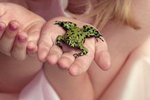
Most of the 13 extant crocodile species have beautifully patterned skin. Unfortunately, a huge fashion market exists for these skins, and many species have become endangered because of overhunting and poaching. More important than the aesthetic pleasure humans derive from crocodile skin, the colors and patterns of this skin have helped crocodiles to survive for millions of years.
Hiding From Predators
As adults, crocodiles have few predators to hide from; the only thing that concerns a large crocodile is an even larger crocodile or a human. Accordingly, cryptic coloration isn’t needed; adult crocodiles are primarily protected by their size and unparalleled aquatic abilities. Young crocodiles are a different matter, and they are on the menu for a variety of predators including snakes, wading birds, raccoons, large fish, turtles and other crocodiles. Juveniles are very well camouflaged; generally they are colored light olive green with numerous dark crossbars and black spots. The heavy patterning of juveniles provides effective camouflage and enables them to hide among the vegetation at the water’s edge.
Hiding From Prey
Young crocodiles consume a wide variety of prey; just about anything small that swims in the water, flies over the surface or hops on the river bank is fair game. To capture these preys, young crocodiles ambush or stalk their prey while relying on their extremely effective skin camouflage to conceal them. As crocodiles age, they usually lose the high-contrast markings and coloring of their youth, usually becoming some uniform shade of dark green or brown. Once this happens, the crocodiles must rely on deep water to hide from potential prey.
Thermoregulation
When all other factors are equal, a larger crocodile takes longer to heat up in the sun than a smaller crocodile does. A 2-foot crocodile may require only a few minutes of time basking in a small patch of sunlight to effectively warm his body, while an adult may need to sprawl out in the sun for several hours to reach effective temperatures for hunting, digesting or mating. The larger animal has less surface area relative to his volume than the smaller animal does. The uniform dark coloration of the adult enables better solar absorption and quicker heating than if he were patterned like a young crocodile.
Variation
Crocodiles live in a number of habitats, and often their colors and patterns are unique to the habitat or region they reside in. For example, dwarf crocodiles (Osteolaemus tetraspis) are often darkly colored, perfect for the small, terrestrial species to camouflage himself on the forest floor. Larger crods occasionally hunt dwarf crocodiles, making the dwarfs' camouflage important not only for capturing prey but also for avoiding predators. Freshwater crocodiles (Crocodylus johnstoni) are small Australian crocodiles who live in billabongs and freshwater lagoons. Adults are normally light green to tan in color -- but several populations of smaller, darker animals have been seen. Though the selective advantage of this color variation is not yet understood, it likely affords better camouflage for their specific locations.
References
Photo Credits
-
John Foxx/Stockbyte/Getty Images




